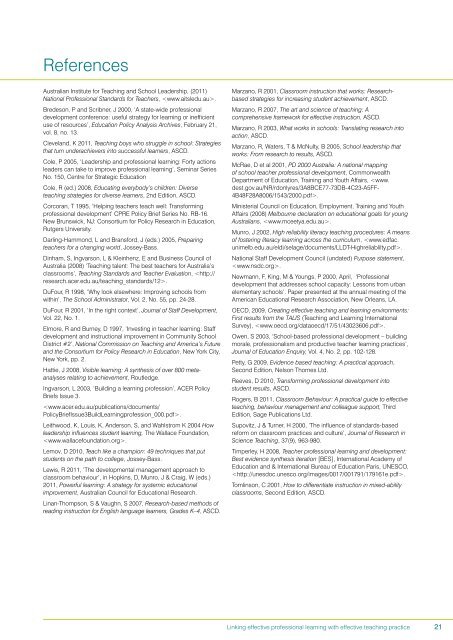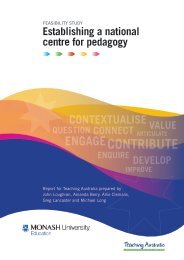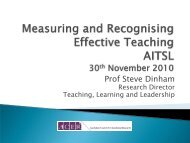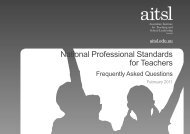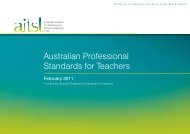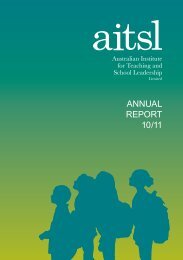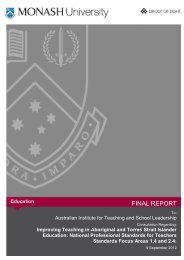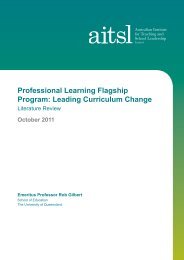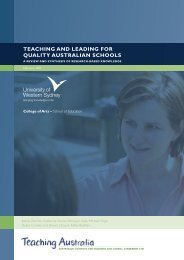Linking effective professional learning with effective teaching practice
Linking effective professional learning with effective teaching practice
Linking effective professional learning with effective teaching practice
Create successful ePaper yourself
Turn your PDF publications into a flip-book with our unique Google optimized e-Paper software.
ReferencesAustralian Institute for Teaching and School Leadership, (2011)National Professional Standards for Teachers, .Bredeson, P and Scribner, J 2000, ‘A state-wide <strong>professional</strong>development conference: useful strategy for <strong>learning</strong> or inefficientuse of resources’, Education Policy Analysis Archives, February 21,vol. 8, no. 13.Cleveland, K 2011, Teaching boys who struggle in school: Strategiesthat turn underachievers into successful learners, ASCD.Cole, P 2005, ‘Leadership and <strong>professional</strong> <strong>learning</strong>: Forty actionsleaders can take to improve <strong>professional</strong> <strong>learning</strong>’, Seminar SeriesNo. 150, Centre for Strategic EducationCole, R (ed.) 2008, Educating everybody’s children: Diverse<strong>teaching</strong> strategies for diverse learners, 2nd Edition, ASCD.Corcoran, T 1995, ‘Helping teachers teach well: Transforming<strong>professional</strong> development’ CPRE Policy Brief Series No. RB-16.New Brunswick, NJ: Consortium for Policy Research in Education,Rutgers University.Darling-Hammond, L and Bransford, J (eds.) 2005, Preparingteachers for a changing world, Jossey-Bass.Dinham, S, Ingvarson, L & Kleinhenz, E and Business Council ofAustralia (2008) ‘Teaching talent: The best teachers for Australia’sclassrooms’, Teaching Standards and Teacher Evaluation, .DuFour, R 1998, ‘Why look elsewhere: Improving schools from<strong>with</strong>in’. The School Administrator, Vol. 2, No. 55, pp. 24-28.DuFour, R 2001, ‘In the right context’, Journal of Staff Development,Vol. 22, No. 1.Elmore, R and Burney, D 1997, ‘Investing in teacher <strong>learning</strong>: Staffdevelopment and instructional improvement in Community SchoolDistrict #2’, National Commission on Teaching and America’s Futureand the Consortium for Policy Research in Education, New York City,New York, pp. 2.Hattie, J 2008, Visible <strong>learning</strong>: A synthesis of over 800 metaanalysesrelating to achievement, Routledge.Ingvarson, L 2003, ‘Building a <strong>learning</strong> profession’, ACER PolicyBriefs Issue 3..Leithwood, K, Louis, K, Anderson, S, and Wahlstrom K 2004 Howleadership influences student <strong>learning</strong>, The Wallace Foundation,.Lemov, D 2010, Teach like a champion: 49 techniques that putstudents on the path to college, Jossey-Bass.Lewis, R 2011, ‘The developmental management approach toclassroom behaviour’, in Hopkins, D, Munro, J & Craig, W (eds.)2011, Powerful <strong>learning</strong>: A strategy for systemic educationalimprovement, Australian Council for Educational Research.Linan-Thompson, S & Vaughn, S 2007, Research-based methods ofreading instruction for English language learners, Grades K–4, ASCD.Marzano, R 2001, Classroom instruction that works: Researchbasedstrategies for increasing student achievement, ASCD.Marzano, R 2007, The art and science of <strong>teaching</strong>: Acomprehensive framework for <strong>effective</strong> instruction, ASCD.Marzano, R 2003, What works in schools: Translating research intoaction, ASCD.Marzano, R, Waters, T & McNulty, B 2005, School leadership thatworks: From research to results, ASCD.McRae, D et al 2001, PD 2000 Australia: A national mappingof school teacher <strong>professional</strong> development, CommonwealthDepartment of Education, Training and Youth Affairs, .Ministerial Council on Education, Employment, Training and YouthAffairs (2008) Melbourne declaration on educational goals for youngAustralians, .Munro, J 2002, High reliability literacy <strong>teaching</strong> procedures: A meansof fostering literacy <strong>learning</strong> across the curriculum, .National Staff Development Council (undated) Purpose statement,.Newmann, F, King, M & Youngs, P 2000, April, ‘Professionaldevelopment that addresses school capacity: Lessons from urbanelementary schools’. Paper presented at the annual meeting of theAmerican Educational Research Association, New Orleans, LA.OECD, 2009, Creating <strong>effective</strong> <strong>teaching</strong> and <strong>learning</strong> environments:First results from the TALIS (Teaching and Learning InternationalSurvey), .Owen, S 2003, ‘School-based <strong>professional</strong> development – buildingmorale, <strong>professional</strong>ism and productive teacher <strong>learning</strong> <strong>practice</strong>s’,Journal of Education Enquiry, Vol. 4, No. 2, pp. 102-128.Petty, G 2009, Evidence based <strong>teaching</strong>: A practical approach,Second Edition, Nelson Thornes Ltd.Reeves, D 2010, Transforming <strong>professional</strong> development intostudent results, ASCD.Rogers, B 2011, Classroom Behaviour: A practical guide to <strong>effective</strong><strong>teaching</strong>, behaviour management and colleague support, ThirdEdition, Sage Publications Ltd.Supovitz, J & Turner, H 2000, ‘The influence of standards-basedreform on classroom <strong>practice</strong>s and culture’, Journal of Research inScience Teaching, 37(9), 963-980.Timperley, H 2008, Teacher <strong>professional</strong> <strong>learning</strong> and development:Best evidence synthesis iteration [BES], International Academy ofEducation and & International Bureau of Education Paris, UNESCO,.Tomlinson, C 2001, How to differentiate instruction in mixed-abilityclassrooms, Second Edition, ASCD.<strong>Linking</strong> <strong>effective</strong> <strong>professional</strong> <strong>learning</strong> <strong>with</strong> <strong>effective</strong> <strong>teaching</strong> <strong>practice</strong>21


